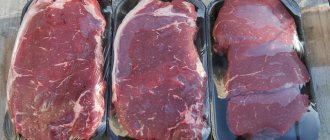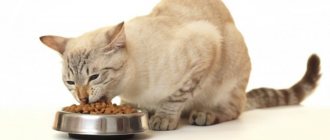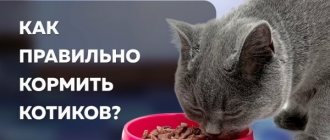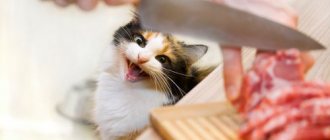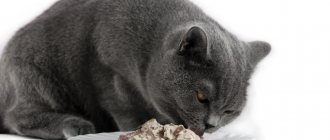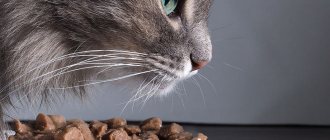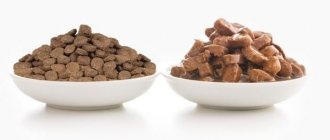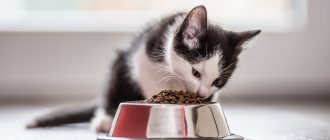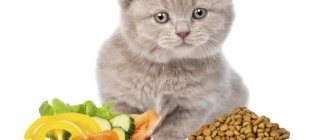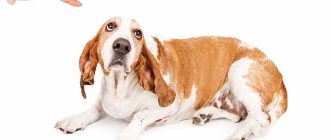Veterinarians believe that chicken meat is a healthy product for cats due to its high protein content, micro- and macroelements. The pet's diet should also contain by-products - kidneys, liver, hearts and stomach. Poultry is the healthiest because it does not contain antibiotics or salt, which is used to artificially increase weight.
About the benefits of chicken meat
It's no secret that chicken meat is considered dietary. It is easily absorbed by the body, so even people weakened after surgery are recommended to first eat nutritious chicken broth, then add white chicken breast meat to the diet.
The big advantage is that chicken meat is inexpensive and cooks quickly. The product contains a large amount of easily digestible protein, and the tender consistency of the meat is liked not only by people, but also by pets. It is provided by a minimal amount of connective tissue. The digestibility of chicken meat is 90%.
Chicken has two types of meat: white and red. Chicken breast meat is commonly called white. It contains less fat and more protein, and is considered dietary because it is low in calories (about 110 kcal per 100 g of product). But veterinarians do not recommend feeding your cat only white meat. Yes, it contains more magnesium, but red contains no less important microelements - iron and zinc, as well as vitamins.
Chicken meat contains vitamins necessary for any living organism, including A, group B (B1, B2, B4, B5, B6, B9 and B12), C, D, E, K, PP. In addition, chicken contains:
- calcium;
- magnesium;
- phosphorus;
- potassium;
- sodium;
- iron and other trace elements.
The rich composition of nutrients allows veterinarians to recommend feeding domestic cats chicken meat - not only the breast, but also other parts of the carcass. However, it is strictly forbidden to give skins and long bones to your cat. Leather is poorly digested in the stomach of pets; moreover, it contains a lot of fat and, if eaten regularly, even in the healthiest cats, will eventually cause problems with the liver, pancreas, and gall bladder. When chewed, tubular bones break into sharp fragments. They can injure the intestines, so they are prohibited for cats.
Chicken for kittens as a permanent food
To the question “Is it possible to feed chicken meat to kittens all the time?” Experts give mixed answers. But they adhere to the fact that in the first three months of life the diet should remain unchanged. Other products are added gradually and in small portions, but chicken meat must be present. You can replace it when the kitten grows up and adapts to heavier products.
Boiled or raw chicken meat is good for kittens for complete nutrition. It is cheap, accessible and easy to digest. If you follow all the rules, your pet will be happy with this dish and will grow up healthy and happy.
Should I give raw or boiled meat?
Cats are carnivores, and in the wild no one cooks food for them, so the digestive system of pets can handle raw meat quite well. Therefore, such food is physiologically closer to cats. Another thing is the individual preferences of animals, which depend on what food the animal has been accustomed to since childhood.
Chicken meat is extremely rarely infected with helminths, so in this regard, a cat eating raw chicken is not in danger. Fish and other types of meat pose a great danger - for example, pork, which veterinarians generally do not recommend giving to cats.
Much more dangerous is the possible infection of a pet with salmonellosis. The causative agents of the disease are Salmonella - bacteria that remain active for a long time and are practically insensitive to low temperatures. But at +75 degrees, pathogenic microorganisms die. A 10-minute heat treatment will be enough to kill germs. A side effect of this treatment is that some of the nutrients are lost. The conclusion suggests itself: cats can have raw chicken meat, but only if it is purchased from a trusted seller and has been tested for salmonella.
Why is salmonellosis dangerous?
Salmonellosis is dangerous not only for cats, but also for humans. And more than a third of domestic animals with strong immunity that have eaten meat contaminated with salmonella will forever remain carriers of the pathology. The weakened body of a cat (small kittens, elderly animals) may not be able to cope with the infection.
The disease is always severe and accompanied by severe symptoms. You can observe in your pet:
- refusal of food;
- attacks of high fever;
- increased body temperature;
- apathy;
- diarrhea, feces have a dark, almost black color and a foul odor, and may contain streaks of blood;
- frequent vomiting with foam;
- cough;
- labored breathing.
The cat may experience severe pain in the abdomen, does not allow it to be touched, and shows aggression. With salmonellosis, the permeability of the vascular walls increases, which accelerates the penetration of pathogenic microorganisms into the body. Without prompt veterinary care, kittens, animals with low immunity and elderly animals die within 1-2 days from dehydration or sepsis.
Raw chicken
Before introducing complementary foods, many owners have a question: “Is it possible to give raw chicken to kittens, and what could be the consequences?” The answer will be ambiguous, because everything depends on its quality. For example, cats and chickens do not share parasites, which is why it is considered safer in its raw form. But the chemical composition of homemade meat will differ from that from a poultry farm.
Products from poultry farms are often saturated with growth hormones, antibiotics and harmful substances. It can be affected by salmonella, E. coli and other infections. Therefore, it is best to cook it before use.
Homemade products, on the contrary, are chemically safer and suitable for feeding kittens. But, if the chicken ran through garbage dumps or came into contact with sick animals, it is possible that it will be sick or with parasites.
You can feed your kitten raw chicken, but you should only buy meat from producers you trust. If it is not possible to buy a high-quality, proven product, then boiled or half-raw chicken is best. To destroy most of the bacteria in raw chicken, it is doused with boiling water, frozen in the freezer for 3-4 days, and then cooked. Complementary feeding begins with boiled meat, and after the intestines have adapted, they are given half-raw and raw.
Is it possible to give heads and paws
Chicken can be the basis of your pet's diet, but you should not feed it chicken breast alone. Already from 3.5-4 months of age, kittens can be given chicken legs, and by about a year - and heads by removing the beak.
Benefits of chicken heads:
- scallops and eyes contain collagen, a component of protein;
- the brain is a source of fat and B vitamins;
- The soft bones of the head ensure the supply of calcium to the cat’s body.
Cats need bones because they are a good source of calcium and phosphorus. By chewing chicken heads, the cat trains its chewing muscles and strengthens its gums.
Important!
It is not recommended to give boiled bones to cats - they clog the animal's digestive tract.
It is recommended to give chicken heads to kittens - during the growth period they need to ensure that their body receives a sufficient amount of protein, fats, and beneficial microelements. Pregnant and lactating cats will benefit from calcium and phosphorus, contained in sufficient quantities in chicken heads.
However, they should be given to pets carefully - no more than one head per meal. Overeating can lead to problems with the digestive system. In addition to heads, you can give cats chicken by-products: liver, kidneys, lungs, hearts.
Important!
Cats usually love liver, but it is best to give it no more than once a week. More frequent consumption of liver negatively affects the appearance of the animal and the quality of the coat.
Kittens and adult cats, as a rule, are reluctant to eat other offal products. Therefore, they are rarely included in the diet of pets. If the cat does not refuse such food, you can give him chicken hearts instead of meat once a week.
Can kittens have boiled meat?
Does a kitten need to cook meat? No no need. He, being a predator, does not need this. Yes, the kitten looks weak and fragile. But that's what you think until you put a piece of raw meat in front of him.
And, nevertheless, kittens can also have boiled meat, it is not poison. However, such nutrition has a number of disadvantages. Firstly, it, as we have already written, is almost completely devoid of useful substances. On a boiled diet, a kitten has to add special vitamin and mineral complexes to its food, which are expensive and often do more harm than good. Secondly, boiled meat is dehydrated, meaning that eating it in large quantities creates a risk of constipation. Thirdly, it is raw fiber that helps adjust the kitten’s digestive enzymes in the right way.
Well, if you only occasionally want to treat your cat to a piece of boiled meat, that’s okay. The main thing is that the basis of the diet is raw.
Dinner is served! Is it possible to feed a kitten chicken?
“Boiled chicken smells so delicious,” the fluffy baby moves towards the kitchen, bumps into the owner’s feet and gently touches it with his paw, trying to attract attention. The owner takes his pet in his arms, realizing that he came to the smell of chicken boiling in a pan and thinks: “Is it possible to feed a kitten chicken?” If yes, in what quantity and how?
How much meat should I give my kitten?
Raw meat for 1 month old kittens is served in a bowl directly into the nest. The mother eats the same food as her kittens. They look at their mother and learn to do everything right. The lactating female is not limited in food: she is allowed to eat several times a day. Let mom eat enough. And kittens will not eat too much meat, because... their main food is still milk. Meat in this case is just training for now.
Raw meat for kittens at 2 months already becomes a complete meal. At this time, they switch to their own provision, gradually abandoning their mother's milk. At this time, the breeder feeds them either natural food, industrial food, or a mixture. Many breeders prefer the mixed version, because... It is unknown what exactly the kitten will eat in its new home. If this is a different type of feeding, then he may develop digestive problems - and the buyer will file a claim with the breeder.
EXPERT COMMENT: CANDIDATE OF BIOLOGICAL SCIENCES GALINA CHILIKINA
“If the nursery fed only one natural female, and the new owners want to switch it to dry food, very serious digestive problems may arise, since aggressive enzymes will be released with the gastric juice, necessary for digesting meat, which are not needed for drying. If, on the contrary, the kitten in the nursery was fed exclusively dry food, and its new owners want to switch it to healthy natural food, the kitten will experience a phenomenon such as an inability to digest this food, since the stomach does not produce the enzymes necessary for this, so the kitten will constantly regurgitate this food, which may be perceived by the owners as a pathology. Diarrhea and other phenomena are also possible.”
Raw meat for kittens at 3 months is already the main food. From 3 months, most have lactose intolerance: due to the large amount of milk, pets can become bloated and diarrhea.
Article continues after advertisement
Small kittens are not limited in the amount of food they eat, giving meat several times a day. But you shouldn’t let them eat a lot at one time. The daily dose is approximately up to 10% of the kitten’s body weight.
At 3 months, many kittens already find a new home, and owners cannot always feed them several times a day. In this case, it is not necessary to switch to dry food, which is always available. A three-month-old kitten can already be fed raw meat like an adult animal: twice or thrice a day, also in a total amount of up to 10% of body weight.
For more information on how often to feed raw meat to your kitten, follow this link. The article indicates feeding standards for Scottish kittens, but the feeding principles described are valid for any breed.
How to give: the best recipes
Cat owners recommend preparing the following simple chicken dishes for natural-fed pets:
- Chicken with vegetables. The breast is boiled and chopped. Add steamed broccoli and carrots in equal proportions. Then a small amount of fresh broth is introduced.
- Liver with garnish. Finely boil and chop 400 g of offal with the addition of 2 tbsp. l. olive or sunflower oil. Add 200 g of steamed oatmeal and 50 g of steamed green peas.
- Kidneys in sauce. Boil and chop 200 g of chicken kidneys. Add 4 tbsp. l. prepared oatmeal and ¼ cup grated carrots. Melted butter of medium fat content - 30 g is poured on top. Then 70 ml of yogurt without additives is added.
- Nutritious breakfast. Boil 70 g of rice. It is better to use unrefined, as it improves intestinal motility. Combine 1 boiled chicken egg in one plate, 1 tbsp. l. chopped carrots and boiled green beans and 20 g of chopped chicken fillet. 3 tsp is introduced. olive fruit oils.
If your cat previously ate exclusively dry food, raw chicken may not be of interest to her. Veterinarians advise boiling it and adding treats that your pet loves.
For babies and older cats, veterinarians recommend placing cooked food in a blender to facilitate digestion and prevent constipation. It is not enough for cats to eat meat in its pure form; the menu must be supplemented with sources of carbohydrates and fiber - bran, vegetables or fruits.
Cats are predatory creatures by nature. In nature, they consume mainly protein, and only a minimal percentage of carbohydrates and fats. Regular cats need twice as much meat as other animals. Therefore, their body is aimed at processing protein, not carbohydrates, and receives the necessary energy from this.
In order to prevent exhaustion and disease of cats, their daily diet should contain not only protein, but also amino acids and vitamins. All of the above elements combine well in chicken meat. However, thermally untreated chicken, despite retaining all the vitamins and important properties, carries various diseases for the “fluffy”. Is it possible to give a cat boiled chicken or still switch him to store-bought ready-made delicacies? We'll figure this out now!
Natural food: we create the menu ourselves
For those who decide to feed their cat natural food, there are several important recommendations.
- Do not try to repeat the menu from the wild - you do not need to get rodents and birds for your pet.
- You should not feed raw meat - it may contain parasites. The meat should be scalded with hot water or placed in the freezer for three days.
- Do not feed the animal from your table - most human food is contraindicated for cats. You need to either prepare special food for your pet or order properly frozen mixtures of natural products from pet stores on the Internet.
Natural foods: what you can and cannot give to cats
| Can | It is forbidden |
| Beef, veal, turkey, rabbit, chicken, offal | Pork and lamb, chicken and any boiled bones |
| Ocean or boiled river fish - 1-2 times a week | Raw river fish |
| Fresh cucumbers, zucchini, carrots, beets, white cabbage | Potatoes, onions and garlic, tomatoes, exotic fruits, mushrooms |
| Dairy products | Milk and dairy products |
| Sprouted oats, wheat or corn, barley porridge | Nuts, seeds and dried fruits |
| Boiled eggs - 1-2 times a week | Bread, pastries, pasta |
| Sweets: chocolate, ice cream, condensed milk, chewing gum Salt and pickles, spices Coffee, cocoa, alcohol | |
| Dog food and cat food not suitable for age group |
Natural nutrition does not imply pure meat - it must contain vegetables, vitamins and microelements. Therefore, “natural food” should be considered by those who have free time, as well as the desire and skills to prepare separate food for their pet and monitor the balance of the diet.
What's wrong with fish and milk?
Cats eat fish and milk in books and cartoons. In real life, milk and dairy products cause diarrhea in most pets. Animals, like people, lose the ability to digest milk with age - the body gradually stops producing enzymes that break down lactose.
When it comes to fish, cat owners are divided into two camps. Opponents believe that raw fish provokes the development of urolithiasis. However, veterinarian Ksenia Kamenskaya notes that she has not come across scientific studies that would confirm this fact.
But there is still a real threat - intestinal parasites. Scalding and freezing fish does not always completely destroy worms. Therefore, if you want to feed your animal fish 1-2 times a week, you should boil it or give your cat anthelmintic drugs once every three months.
Is it possible to mix industrial and natural food?
Veterinarians recommend choosing one type of feeding and sticking to it. If you give your cat premium food, an additional piece of natural meat will upset the balance of the diet. Therefore, you should not mix.
But you can offer your pet vegetables in addition to canned food. In addition, if part of the animal protein is replaced with vegetable protein in the finished food, a little chicken breast or beef will not hurt.
Can a cat have boiled chicken?
Animals should definitely include meat products in their diet, but can a cat have boiled chicken? Poultry meat is perfect for feeding adults and even small kittens, because it has a delicate texture and contains many useful substances. Therefore, you can give boiled chicken to kittens when you understand whether they have learned to chew.
As a first complementary food, boiled chicken meat for kittens is very popular because it is soft, contains large amounts of protein, vitamins, amino acids and the necessary amount of fat, and is easy to digest. An additional advantage is that chicken is inexpensive, cooks quickly, and is easy to remove from the bones. This is why owners love to use this meat to feed their pets. Plus, you can buy it in any store, unlike, for example, rabbit meat.
How to make meat safe for your cat
Many types of meat can be given to domestic cats. It is better to regularly change the types of meat, giving preference to organic types, the cultivation of which did not use chemical additives and antibiotics. If the owner gives the pet the same type of raw meat, the risk of developing a deficiency of beneficial nutrients increases.
The following types of raw meat are suitable for feeding cats:
- chicken fillet (breast) and thigh meat;
- pieces of steak - it is recommended to take pieces of meat with veins, since such types of meat are preferable for digestion and improving the condition of the gums;
- pieces of rabbit meat;
- turkey fillets, wings and thighs;
- chicken necks and wings;
- lamb heart and kidneys.
When choosing the type of raw meat for a pet, the owner must pay special attention to the quality of the product. It is forbidden to feed the animal spoiled food (meat with flavor). When buying meat in a supermarket, you must carefully monitor the production date indicated on the packaging.
Giving your cat sausages instead of raw meat is prohibited. Ready-made semi-finished products contain a large amount of sodium chloride and spices that are prohibited for consumption by pets.
How to read labels: what should be in the food
Ingredients are usually listed by weight on the label. For example, in wet food, beef, fish, chicken and turkey will be at the top of the list, but in dry food they may be at the very end due to the excess moisture being removed from them. Experts warn that the packaging may not contain complete information. If in doubt, it is better to consult a doctor or go to the manufacturer’s website and contact support.
How to read the label:
First step
- look at the name and compare with the composition. It should consist of 35–95%, not counting water, of the product stated in the name. For example, if it is rabbit food, then the main ingredient should be rabbit meat.
Second step
— check the entire list of components.
Cats are descendants of semi-desert carnivores, so they need a lot of protein, a moderate amount of fat and a minimum of carbohydrates. And also vitamins, minerals, fatty acids and amino acids. Therefore, check that the composition contains animal protein - cats need taurine and Omega-6 arachidonic acid, which are found only in animal and poultry meat or offal. These elements cannot be obtained from plant foods, so vegetarianism is contraindicated for cats.
Useful and harmful components in cat food
- Protein - beef, chicken, turkey, rabbit - at least 35%.
- Fiber - oats, wheat, rice, and carbohydrates - no more than 25%, otherwise the cat may have an upset stomach.
- By-products - at least 30% of the composition.
- Vitamins and mineral supplements: taurine, Omega-6 arachidonic acid, calcium, vitamin A, E, K, B vitamins, ascorbic acid, zinc, copper, amino acids. Vitamin D is essential for kittens.
- Dye E127 can provoke cancer.
- Oxidizing agents E320 and E321 can damage the liver, cause seizures and neuroses.
- Waste - skin, cartilage, feathers, horns, beaks, hooves. If a specific protein source is not indicated on the packaging, the manufacturer may be hiding the fact that the food is made from waste.
Veterinarian Ivan Ryzhov notes that food containing chicken should be given to pets with caution. This is a strong allergen, the effect of which does not appear immediately. Therefore, if your cat has itching or dull fur, check the composition and consult a doctor.
Are by-products healthy?
Many owners avoid them because I think that waste - horns, hooves, skin, beaks - also falls into this category. But by-products are internal organs, such as liver, kidneys, lungs, heart. They are healthy, nutritious and easily digestible by the cat's body. The food packaging must list the specific by-products that it contains.
What to do?
If you want to feed your cat chicken, go ahead! But in our realities, it is better to feed her boiled chicken so that she does not become infected with salmonellosis or any other dangerous bacteria. When cooking, some vitamins, of course, will be destroyed, but the cat will be able to replenish them with other food (that is, the cat cannot be fed only chicken - its diet should be as varied as possible ).
Remember that salmonella in meat dies in 10 minutes at a temperature of 75 degrees . That is, cook the chicken, chicken hearts and chicken livers longer, and don’t just scald them with boiling water.
What will a cat choose: boiled or raw chicken?
Signs of salmonellosis in cats
If you feed your cat raw chicken, carefully monitor its condition. If she suddenly developed :
- diarrhea (usually with blood); - the temperature has increased; - weakness and apathy developed; - vomiting began; - Appetite has deteriorated greatly.
Contact your veterinarian immediately .
Firstly, because a cat can die due to salmonellosis, and secondly, because it can infect people who come into contact with it.
Types of cat food
Industrial feeds are divided into three types:
- dry,
- semi-dry,
- wet.
| Dry (6-10% moisture) | Semi-dry (35% moisture) | Wet (75% moisture) | |
| Compound | Meat, fish, poultry or organ meats, grains, vitamins and mineral supplements | Meat, fish, poultry or by-products, grains, vitamins and mineral supplements, preservatives | Meat, fish, poultry or by-products, grains, vitamins and mineral supplements, preservatives |
| pros | The best ratio of price and feed consumption. Prevents the formation of dental plaque. It can be stored for a long time. | Smells and tastes attractive to cats. Suitable for cats that cannot eat dry food. | Provides the cat's need for water. Suitable for sick and elderly animals. The most delicious food, liked by most cats. |
| Minuses | Weak smell and taste. You need to make sure your cat always has water. | Costs more than dry. Contains more sugar than other types of food. If opened, it dries out or deteriorates quickly. | High price. It deteriorates quickly when opened. |
Dry and semi-dry food
It’s most convenient for owners who feed their pets on a flexible schedule: if you pour dry food into a bowl in the morning, it will remain fresh and tasty until the evening. This is also a suitable option for cases when you need to go away for 1-2 days and leave the cat alone. The main disadvantage of dry food is that it contains virtually no moisture, so the animal should always have fresh water in a bowl, water bottle or drinking fountain.
In July, Roskachestvo published a rating of 39 feeds from well-known manufacturers. The top 5 brands included:
Dry and semi-dry food should be stored in a hermetically sealed bag, monitor the expiration date and not buy in bulk - it is unknown how long they have been left open.
Wet food
Suitable for sick and convalescent cats, as well as old animals that find it difficult to chew dry pellets. This food contains enough liquid, so cats drink very little.
The main disadvantage is that spiders and canned food spoil quickly. If the cat does not eat the portion immediately, after half an hour the product will dry out and dry out in the evening. Therefore, the leftover food is thrown away, and the printed packaging is stored in the refrigerator, tightly closed, for no more than 2-3 days.
Another disadvantage of wet food is that it does not prevent the formation of plaque. Therefore, if your cat eats canned food, then she needs to brush her teeth periodically.
Careful, treats!
When choosing wet food, be sure to check that it is suitable for daily feeding. Sometimes owners confuse it with a treat. For example, it could be pouches or gourmet canned food. And although they look the same, this is just a “dessert” and not a full meal.
Treats are needed to restore interest in food in a sick or picky cat, or to pamper an animal if it is stressed from moving, having a new pet, or changing owners.
Is it possible to mix?
Experts believe that it is acceptable to give your cat both dry food and canned food at once. But it is important to consider two points:
- do not mix different types of food in one bowl;
- choose food from one manufacturer.
Products from different companies are mixed just to switch a cat from one type to another.
Dry and wet industrial food can be given together if it is the same brand and line - they differ only in the amount of water in the composition. It is important that both foods contain the same type of protein - for example, you should not give dry food with fish, or wet food with turkey.
Feed classes
Industrial cat food is divided into three classes:
- Economy
- Premium and superpremium
- Holistic
The classification is based on the quantity and quality of products. The price also depends on the class.
Economy class
At first glance, this is the most budget option. But these foods can cause health problems for animals due to their low protein content, high amounts of soy, artificial colors and oxidizing agents. Sometimes they may even consist of bran alone. Cheap food is similar to fast food for people and is useful in much the same way as instant soups.
As a dermatologist, I very often encounter unwanted food reactions - itching, irritation and hair loss - to economy class spiders. These foods contain insufficient quantity and quality of protein to keep your cat healthy, as well as questionable quality ingredients. In addition, many flavoring additives are added to make the food more appetizing to the animal.
It turns out that the low price of economy food is deceptive - after all, such food will most likely require the owner to spend money on a veterinarian and medications. In addition, supposedly budget wet food is actually more expensive than premium dry food.
Let's look at the example of a hypothetical three-kilogram sterilized cat and premium food. The cost of a package weighing 2 kg is approximately 1000 rubles, the daily requirement of a cat is about 50 g. It turns out that such a package will last for 40 days, 25 rubles per day. A bag of economy class food costs an average of 20 rubles. And this is only for one feeding, and there are two or three of them a day - a total of 40-60 rubles. It turns out that the dry premium diet is almost 2 times cheaper than the wet economy diet.
Premium class
According to experts, this is the best ready-made food option that suits most animals. Nutritionists work on the composition, monitoring not only the quality of the products, but also the method of their preparation. For example, cheap canned food has few nutrients - they are partially destroyed during heat treatment. In expensive feeds, the possibility of such losses is taken into account in advance.
Holistic and medicinal foods
Separately, there are “holistic” or Human Grade foods. All of their ingredients are suitable for human use. It contains a lot of protein - fresh meat, easily digestible carbohydrates - potatoes, peas, lentils, fiber - vegetables, fruits, berries. And also natural preservatives and high-quality vitamin and mineral supplements.
Veterinarian Tatyana Khleborad notes that such food is suitable for animals that have an additional burden - for example, they are free-range, pregnant or sterilized.
Two in one?
Some people wonder: is it possible to feed a kitten chicken by mixing raw and boiled meat in one meal? Experts do not recommend resorting to this method of feeding, since different enzymes are secreted in the cat’s stomach to digest boiled and fresh meat in the stomach. Therefore, such a mixture will be hard on the stomach, especially for a small kitten.
In conclusion, I would like to give a few general rules for feeding kittens:
- food should not be cold or hot, but warm, approximately at room temperature;
- dice are not given under any circumstances;
- In order for the baby to cope with the portion, the chicken is torn into small pieces
- It is advisable to place the bowl for drinking and food in a low-traffic and quiet place so that the pet can eat food calmly.
- small kittens eat often, up to 5-6 times a day (you can ensure constant access to food). After 6 months, the number of meals is reduced to 3 times a day. At the age of eight months, the animal is transferred to two meals a day.
According to experienced veterinarians and felinologists, chicken contains all the fats cats need. In any case, the main rule: the product must be fresh and of high quality. You can add fresh grated carrots to raw chicken, while boiled chicken is best served with vegetables to avoid constipation.
